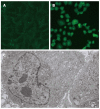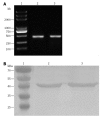Expression of hepatitis B virus 1.3-fold genome plasmid in an SV40 T-antigen-immortalized mouse hepatic cell line
- PMID: 24307795
- PMCID: PMC3848149
- DOI: 10.3748/wjg.v19.i44.8020
Expression of hepatitis B virus 1.3-fold genome plasmid in an SV40 T-antigen-immortalized mouse hepatic cell line
Abstract
Aim: To investigate the expression of the hepatitis B virus (HBV) 1.3-fold genome plasmid (pHBV1.3) in an immortalized mouse hepatic cell line induced by SV40 T-antigen (SV40T) expression.
Methods: Mouse hepatic cells were isolated from mouse liver tissue fragments from 3-5 d old Kunming mice by the direct collagenase digestion method and cultured in vitro. The pRSV-T plasmid was transfected into mouse hepatic cells to establish an SV40LT-immortalized mouse hepatic cell line. The SV40LT-immortalized mouse hepatic cells were identified and transfected with the pHBV1.3 plasmid. The levels of hepatitis B surface antigen (HBsAg) and hepatitis B e antigen (HBeAg) in the supernatant were determined by an electrochemiluminescence immunoassay at 24, 48, 72 and 96 h after transfection. The expressions of HBsAg and hepatitis B c antigen (HBcAg) in the cells were investigated by indirect immunofluorescence analysis. The presence of HBV DNA replication intermediates in the transfected cells and viral particles in the supernatant of the transfected cell cultures was monitored using the Southern hybridization assay and transmission electronic microscopy, respectively.
Results: The pRSV-T plasmid was used to immortalize mouse hepatocytes and an SV40LT-immortalized mouse hepatic cell line was successfully established. SV40LT-immortalized mouse hepatic cells have the same morphology and growth characteristics as primary mouse hepatic cells can be subcultured and produce albumin and cytokeratin-18 in vitro. Immortalized mouse hepatic cells did not show the characteristics of tumor cells, as alpha-fetoprotein levels were comparable (0.58 ± 0.37 vs 0.61 ± 0.31, P = 0.37). SV40LT-immortalized mouse hepatic cells were then transfected with the pHBV1.3 plasmid, and it was found that the HBV genome replicated in SV40LT-immortalized mouse hepatic cells. The levels of HBsAg and HBeAg continuously increased in the supernatant after the transfection of pHBV1.3, and began to decrease 72 h after transfection. The expressions of HBsAg and HBcAg were observed in the pHBV1.3-transfected cells. HBV DNA replication intermediates were also observed at 72 h after transfection, including relaxed circular DNA, double-stranded DNA and single-stranded DNA. Furthermore, a few 42 nm Dane particles, as well as many 22 nm subviral particles with a spherical or filamentous shape, were detected in the supernatant.
Conclusion: SV40T expression can immortalize mouse hepatic cells, and the pHBV1.3-transfected SV40T-immortalized mouse hepatic cell line can be a new in vitro cell model.
Keywords: Hepatitis B virus 1.3-fold genome plasmids; Immortalized; Liposomes; Mouse hepatic cell; SV40 T-antigen; Transfection.
Figures






Similar articles
-
[An in vitro model of hepatitis B virus gene replication and expression in primary rat hepatocytes transfected with circular viral DNA].Zhonghua Gan Zang Bing Za Zhi. 2002 Aug;10(4):275-8. Zhonghua Gan Zang Bing Za Zhi. 2002. PMID: 12223138 Chinese.
-
Construction and expression of eukaryotic plasmids containing lamivudine-resistant or wild-type strains of Hepatitis B Virus genotype C.World J Gastroenterol. 2008 Jun 21;14(23):3733-8. doi: 10.3748/wjg.14.3733. World J Gastroenterol. 2008. PMID: 18595141 Free PMC article.
-
[Study on the replication of Hepatitis B Virus in primary hepatocytes from heterogenous species].Zhonghua Gan Zang Bing Za Zhi. 2004 Jan;12(1):25-8. Zhonghua Gan Zang Bing Za Zhi. 2004. PMID: 14761278 Chinese.
-
Production of hepatitis B virus by stably transfected monocytic cell line U-937: a model for extrahepatic hepatitis B virus replication.J Infect Dis. 1992 May;165(5):929-33. doi: 10.1093/infdis/165.5.929. J Infect Dis. 1992. PMID: 1569345
-
The immortalized cell lines with differentiation potentials: their establishment and possible application.Cancer Sci. 2007 Mar;98(3):275-83. doi: 10.1111/j.1349-7006.2007.00399.x. Epub 2007 Jan 12. Cancer Sci. 2007. PMID: 17233813 Free PMC article. Review.
References
-
- Chen CJ, Yang HI, Su J, Jen CL, You SL, Lu SN, Huang GT, Iloeje UH. Risk of hepatocellular carcinoma across a biological gradient of serum hepatitis B virus DNA level. JAMA. 2006;295:65–73. - PubMed
-
- Schiff ER, Lee SS, Chao YC, Kew Yoon S, Bessone F, Wu SS, Kryczka W, Lurie Y, Gadano A, Kitis G, et al. Long-term treatment with entecavir induces reversal of advanced fibrosis or cirrhosis in patients with chronic hepatitis B. Clin Gastroenterol Hepatol. 2011;9:274–276. - PubMed
-
- Shepherd J, Jones J, Takeda A, Davidson P, Price A. Adefovir dipivoxil and pegylated interferon alfa-2a for the treatment of chronic hepatitis B: a systematic review and economic evaluation. Health Technol Assess. 2006;10:iii–iv, xi-xiv, 1-183. - PubMed
Publication types
MeSH terms
Substances
LinkOut - more resources
Full Text Sources
Other Literature Sources

